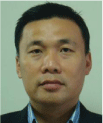Cost-effective and modular CO2 capture to support decarbonisation for oil and gas, industrial and hard-to-abate sectors
Jai Kant Pandit A * and Kwong Soon Chan AA

Dr Jai Kant Pandit has PhD in Chemical Engineering from Monash University and has broad experience and interests in sustainability, emissions reduction, waste utilisation, hydrogen energy and power generation. Dr Pandit has been with CO2CRC for 8 years, before which he worked for Babcock & Wilcox and Alstom Power. Dr Pandit has been active in post-combustion capture project management and demonstration projects in Victoria’s Latrobe Valley on CO2 capture and hydrogen production. He is currently developing CO2CRC’s direct air capture technology and cost-effective, modular, and hybrid HyCaps process to capture CO2. |

Kwong Soon (KS) Chan has extensive experience across the energy and resource sector, having worked in energy, oil and gas, mining, infrastructure and start-ups in Asia Pacific, Europe, and the Middle East. He has gained experience working in different capacities, from field engineering, sales and marketing, operations, strategy, QHSE (Quality, Health Safety and Environment), project management, research, and development to senior management. He was the Senior Manager (Carbon Capture and Utilisation Program Lead) and currently is the Chief Commercialisation Officer with CO2CRC Limited. |
Abstract
Reducing emissions from the industrial and fossil fuel-based power sectors is crucial to achieving net zero emissions. These sectors contribute to ~60% of global carbon dioxide (CO2) emissions. However, there are several challenges that current CO2 capture technology faces. The use of coal in steel and cement industries produces flue gases with high CO2 content but also with nitrogen and sulfur oxides (NOx and SOx) as impurities. These impurities cause faster degradation of amine-based solvents in the current CO2 capture system. Additionally, capturing CO2 from flue gases from the hard-to-abate sector, such as steel plants, is complex as it is not easy to capture CO2 from multiple sources and different CO2 concentration flue gas streams. For cement and other kiln processes, limited availability of water/steam can add to the difficulty and cost of CO2 capture. CO2CRC’s HyCaps process, an efficient and compact hybrid of solvent absorption and membrane technology, overcomes some of these challenges. It takes advantage of the capture efficiency of the solvent system, controlled flow regime and high surface-to-volume ratio of membrane technology. The mode of interaction between gas and liquid in HyCaps limits solvent exposure to NOx and SOx, reducing solvent degradation. In HyCaps, as solvent is regenerated at a lower temperature, low-quality, low-cost waste heat can be effectively utilised to reduce operational expenditure. Successful trials at three different industrial setups and preliminary techno-economic analysis from test trial data show the HyCaps process has the potential to offer very competitive capture solutions for various industrial settings.
Keywords: CO2 capture, compact, cost-effective, FLNG, FPSO, hard to abate, HyCaps, low-quality waste heat.
 Dr Jai Kant Pandit has PhD in Chemical Engineering from Monash University and has broad experience and interests in sustainability, emissions reduction, waste utilisation, hydrogen energy and power generation. Dr Pandit has been with CO2CRC for 8 years, before which he worked for Babcock & Wilcox and Alstom Power. Dr Pandit has been active in post-combustion capture project management and demonstration projects in Victoria’s Latrobe Valley on CO2 capture and hydrogen production. He is currently developing CO2CRC’s direct air capture technology and cost-effective, modular, and hybrid HyCaps process to capture CO2. |
 Kwong Soon (KS) Chan has extensive experience across the energy and resource sector, having worked in energy, oil and gas, mining, infrastructure and start-ups in Asia Pacific, Europe, and the Middle East. He has gained experience working in different capacities, from field engineering, sales and marketing, operations, strategy, QHSE (Quality, Health Safety and Environment), project management, research, and development to senior management. He was the Senior Manager (Carbon Capture and Utilisation Program Lead) and currently is the Chief Commercialisation Officer with CO2CRC Limited. |
References
Dashliborun AM, Larachi F, Taghavi SM (2019) Gas-liquid mass-transfer behavior of packed-bed scrubbers for floating/offshore CO2 capture. Chemical Engineering Journal 377, 119236.
| Crossref | Google Scholar |
GCCSI (2023) CO2CRC. HyCaps- Hybrid Capture Solution. In ‘Technical Report- State of the Art: CCS Technologies 2023’. (Eds H Barlow, SSM Shahi, M Loughrey) pp. 48–51. (GCCSI) Available at https://www.globalccsinstitute.com/wp-content/uploads/2023/08/State-of-the-Art-CCS-Technologies-2023-GCCSI-Final.pdf
Pandit JK, Watson M, Qader A (2020) ‘Reduction of Greenhouse Gas Emissions in Steel Production.’ (NSW Department of Primary Industries) Available at https://www.resourcesregulator.nsw.gov.au/sites/default/files/2022-11/report-reduction-of-ghg-emissions-in-steel-industries.pdf
The Energy Transitions Commission (2018) ‘Mission Possible: Reaching net-zero carbon emissions from harder-to-abate sectors.’ (The Energy Transitions Commission) Available at https://www.energy- transitions.org/publications/mission-possible/


